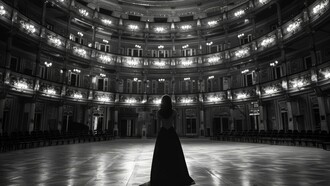Mandav, the ancient city in Central India, is a paradise for people who love the idea of peeking into the forgotten time. Centuries ago, Mandav was the epicenter of power, heritage, culture, architecture, and beauty. A Muslim ruler named it "Shadibad," “The City of Joy.”
The kings are gone. Their armies serve no more. No queen peeps from the jharokhas (windows), and no conquerors march towards the walled city, but the ruins still speak of the glory of the past.
I have been to Mandav over a hundred times—for family get-togethers, school picnics, to attend Mandav Utsav (the local cultural festival), for long drives (only 35 km away from my home), and several times without any specific reason. It could be due to the genetically coded love for history, architecture, and nature, but this ancient city has always been one of my favorite places.
Every time that I visited Mandav, I saw it from a different lens. And the more I knew Mandav, the more I fell in love with it.
Now, when I write about my travel anecdotes, not talking about this city seems impertinent. So, let me introduce you to Mandav.
Mandav: the ancient city
Mandav, or Mandu, is located in India in the Malwa and Nimar regions of Madhya Pradesh in the Dhar District. It sits on the Vidhya Range (at an elevation of 2,079 feet or 633 meters), guarded by the Malwa plateau in the north and the valley of the river Narmada to its south.
Its history dates back to the 6th century, but the city ascended to fame in the 10th or 11th century during the rule of the Paramara Dynasty. However, Mandav rose to its full glory during the rule of Hoshang Shah Ghori. Later, the rulers that walked behind contributed their bit to make this city what it is today—an epitome of glory, grace, and beauty.
The architectural marvels and folklore of Mandav
Hundreds of years ago, Mandav served several rulers and dynasties, and today, it satiates the desires of people wanting to dive deep into the glory of the bygone era.
The grand palaces, sublime pavilions, majestic mosques and temples, and other architectural marvels like reservoirs and wells still tell the stories of the glorious past.
Mandav is home to several remarkable structures, including the Jahaj Mahal, Hindola Mahal, Hoshang Shah’s Tomb, Ashrafi Mahal, Baz Bahadur Palace, Roopmati’s Pavilion, Chaturbhuj Ram Temple, Champa Bawdi, Rewa Kund, Jami Masjid, Darwazas (gateways), and many others.
Let me walk you through some of the most striking structures of Mandav.
Darwazas (Gateways)
Mandu was a critical military outpost guarded by a battlement wall, which is around 37 km. The well-fortified circuit features 12 gateways or Darwazas, including Delhi Darwaza, Alamgir Darwaza, Bhangi Darwaza, Jehangir Gate, Rampol Darwaza, and more.
One has to pass through several of these gates to reach Mandav.
Hoshang Shah’s Tomb
Perhaps the most gorgeous embodiment of Afghan architecture, Hoshang Shah’s Tomb was the first marble structure in India.
The structure features gorgeous domes, exquisite marble latticework, ornate tiles, and well-formed arches.
Hoshang Shah’s Tomb is said to be the inspiration behind the architectural wonder, the Taj Mahal.
Ashrafi Mahal
Ashrafi Mahal is a majestic structure standing right across from the Jami Masjid. Ashrafi Mahal translates to the “Palace of Gold Coins” and comprises three different structures built at different times.
The building was initially constructed to serve as an academic institution, a madrassa—a series of rooms encapsulating a courtyard and four towers. Later, a terrace was built to house Mahmud Khilji’s mausoleum, which could be reached by a flight of steps.
The third structure was constructed in 1443. The Tower of Victory, made of red sandstone, was constructed on the northeast corner of the compound.
There is an interesting folklore associated with the palace. It is said that Ghiyas-ud-din Khilji asked all his obese wives to climb the staircase of the palace regularly in order to lose weight and promised to give them Ashrafis (gold coins) in return.
Baz Bahadur Palace and Roopmati’s Pavilion
Baz Bahadur, the last sultan of Malwa, built his palace in the 16th century. Just above the palace sits Rani Roopmati’s Pavilion, which was originally constructed as an army observation post.
These spectacular structures aren’t just an example of awe-inspiring architecture but are also a symbol of true love.
Baz Bahadur fell in love with Roopmati while he was on a hunting spree and urged her to go with him. She agreed to marry him on the condition that she would live in a palace from where she could see the river, Narmada.
Baz Bahadur transformed the army observatory post into Roopmati’s abode and created a pavilion from where she could see the Narmada River and his palace, perched right below.
Jami Masjid
The grand Jami Masjid of Mandav draws its inspiration from the great mosque of Damascus. The grand structure comprises an enormous dome, large courtyards, and a gorgeous placement of pillars and arches.
Jahaz Mahal
One of the most gorgeous palaces in Mandav, the Jahaz Mahal, is perched between two man-made lakes. It was constructed by Ghiyas-ud-din Khilji.
Jahaz Mahal, or Ship Palace, is a two-storied structure that serves the most breathtaking views. It appears as if a ship is floating in water.
Hindola Mahal
Hindola Mahal, or Swing Palace, derives its name from its sloping walls. It served as a durbar or meeting hall back in those days.
The gorgeous structure features several architectural marvels, including Champa Baoli, Dilwas Khan’s mosque, Taveli Mahal, and Nahar Jharokha (tiger balcony), to name a few.
The final note
Mandav has witnessed several empires rise in glory. It is also a testament to kingdoms shattering into pieces. It has rejoiced a poetic romance and sobbed for people robbed of their lives. It has seen the melancholy of wars and battles and the splendor of war heroes.
The tales and folklore still reverberate in the air of this ancient city, and the majestic forts and palaces can teleport anyone to bygone eras.
Mandav is truly an architectural, historical, and cultural landmark.














